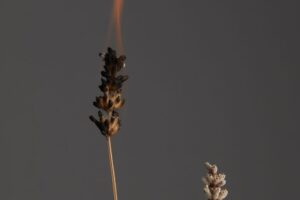
Lilies are beautiful and delicate flowers that can brighten up any garden or room. However, if your lily buds are turning brown, it can be cause for concern. Browning lily buds could mean a variety of things from insect infestation to environmental stress.
Understanding the cause of your lily buds turning brown is the first step in finding a solution and keeping your lilies in bloom.
What Causes Lily Buds to Turn Brown?
Lily buds turning brown can be caused by a variety of factors, including nutrient deficiency, water stress, pests, and disease. Inadequate nutrients, such as nitrogen, can lead to yellowing of the leaves and browning of the buds. Poor irrigation can lead to water stress, resulting in the buds drying out and turning brown.
Moreover, lily buds can be susceptible to pests and disease, such as aphids, botrytis blight, and fusarium wilt, all of which can cause the buds to turn brown.
To prevent lily buds from turning brown, it’s important to keep the plants well-fed, adequately watered, and regularly monitored for signs of pests and disease.
How to Diagnose Brown Lily Buds
Brown lily buds could be a sign of a variety of issues, often related to plant disease or improper care. Please keep in mind that diagnosing a plant’s issues remotely can be challenging and may not be 100% accurate. Here are a few possible causes:
- Fungal Diseases: This is a common cause of browning in many types of plants, including lilies. Botrytis blight, also known as Botrytis cinerea, is a common fungus that affects lilies. The fungus appears as spots on leaves and buds, which can turn brown and cause the plant to decay.
- Bacterial Diseases: Bacterial soft rot, caused by a bacterium named Pectobacterium carotovorum subsp. carotovorum, is another disease that can cause browning in lilies. It generally affects the bulb, but can move upward affecting the buds.
- Improper Watering: Both overwatering and underwatering can lead to browning buds. Overwatering can lead to root rot, while underwatering can lead to dehydration.
- Excessive Heat or Cold: Lilies generally prefer cool to moderate temperatures. If they’re exposed to intense heat or cold, it can cause browning.
- Pests: Certain pests, such as aphids, red spider mites, and lily beetles, can cause damage to lilies that could result in browning.
To determine the exact cause, closely examine your lily plant. Look for signs of pests, check the dampness of the soil, inspect for any visible fungus or bacteria, and consider recent weather conditions. You may also want to consider having a professional horticulturalist or extension service examine the plant if you’re unable to determine the cause.
Preventing Brown Lily Buds
To prevent browning of lily buds, consider the following best practices in plant care:
- Proper Watering: Ensure the lilies are watered correctly. They generally prefer soil that is damp but not soggy. Overwatering can lead to diseases such as root rot, while underwatering can cause the plant to become dehydrated and brown.
- Right Location: Lilies should be planted in a location where they can get at least six hours of sunlight daily but avoid intense afternoon sun if possible. Too much heat can cause the buds to brown.
- Proper Spacing: Ensure your lilies are adequately spaced to promote good air circulation. This can help to prevent the development and spread of fungal diseases.
- Healthy Soil: Plant lilies in well-draining soil to prevent waterlogging and root rot. You can also enrich your soil with compost or a slow-release fertilizer to ensure the lilies are getting the nutrients they need.
- Pest Control: Regularly inspect your lilies for signs of pests such as aphids, lily beetles, or red spider mites. If you find pests, you may need to treat the plant with an appropriate pesticide or insecticidal soap.
- Regular Cleaning: Prune and clean up fallen debris around your lilies regularly. This can help to prevent the spread of diseases.
- Disease Control: If you notice a lily that appears to be sick, it’s often best to remove it immediately to prevent the disease from spreading to other plants. You can also consider using fungicides or antibacterial sprays if your plants are prone to such diseases.
- Rotate Planting Areas: If feasible, try not to plant lilies in the same spot year after year. This can help to prevent soil-borne diseases.
By following these best practices, you can help to keep your lilies healthy and prevent issues that can lead to browning buds. However, remember that not all issues can be prevented, and even with the best care, plants can sometimes get sick. Regular observation and early intervention are key to maintaining healthy plants.

Types of Lily Bulbs that are Prone to Brown Buds
Many types of lilies can be prone to browning buds if they’re not cared for properly, but some may be more susceptible due to their specific needs and vulnerabilities. Here are a few types that might be more prone to this issue:
- Oriental Lilies: Oriental lilies are known for their stunning flowers and strong fragrance. However, they are also known to be a bit more delicate and susceptible to issues like browning buds if not properly cared for.
- Asiatic Lilies: Asiatic lilies, while generally robust, can also be prone to browning buds. They are less fussy about their conditions than Oriental lilies, but they can still experience issues if not cared for correctly.
- Trumpet Lilies: These lilies are known for their trumpet-shaped flowers. They can be prone to diseases like botrytis blight, which can cause browning buds, especially in damp conditions.
- Tiger Lilies: These lilies are quite tough and usually resistant to most diseases. However, they can be susceptible to lily mosaic virus, spread by aphids, which can cause browning among other symptoms.
- Easter Lilies: These are popular indoor lilies, especially during the Easter season. Indoor conditions can sometimes lead to problems like poor ventilation and overwatering, which can in turn lead to diseases that cause browning buds.
Remember, even though certain types of lilies might be more susceptible, the environment and care they receive are significant factors in their overall health. Regularly checking on your lilies and providing the appropriate care can help prevent issues like browning buds. If you notice problems, try to identify the cause as soon as possible and adjust your care routine as necessary.
Common Treatments for Brown Lily Buds
The treatment for brown lily buds will depend on the underlying cause of the problem. Here are some common treatments based on the typical causes:
- Fungal Infections: Fungicides are often used to treat fungal infections. These are available in many forms and can be applied to the affected areas according to the manufacturer’s instructions. It’s important to catch the infection early to avoid it spreading to other parts of the plant or to other plants in your garden.
- Bacterial Diseases: If a bacterial disease is causing the browning, antibacterial sprays can be used. In severe cases, it might be necessary to remove the affected parts of the plant or even the entire plant to prevent the disease from spreading.
- Improper Watering: If overwatering or underwatering is causing the browning, adjust your watering schedule accordingly. Lilies prefer to be watered deeply but infrequently, allowing the soil to dry out slightly between watering.
- Heat Stress: If the browning is due to heat stress, try moving the lilies to a location where they receive morning sunlight and afternoon shade, and ensure they’re getting enough water.
- Pest Control: If pests are causing the damage, insecticides or natural predators can be used to control the pest population. Insecticidal soaps or neem oil can also be effective in controlling many pests.
- Improving Plant Health: Sometimes, improving the overall health of the plant can help. This can involve fertilizing the plant to ensure it’s getting the nutrients it needs, pruning back dead or diseased parts of the plant, or improving the soil condition.
- Disease Resistant Varieties: If a particular type of lily is continually having problems, consider planting disease-resistant varieties instead. These varieties are bred to be less susceptible to common diseases and pests.
Remember, before applying any chemical treatment, be sure to read and follow the manufacturer’s instructions. Also, consider whether non-chemical methods could be effective before resorting to chemical treatments. In some cases, a combination of treatments may be necessary to fully address the problem.
Troubleshooting Tips for Brown Lily Buds
If you’re facing the problem of brown lily buds, here are some troubleshooting tips to help identify and address the issue:
- Check for Fungal or Bacterial Infections: Look for other signs of fungal or bacterial diseases, like spots, mold, or a slimy appearance. If you suspect a fungal or bacterial disease, consider treating with a fungicide or antibacterial spray.
- Inspect for Pests: Check the entire plant, including the underside of leaves, for signs of pests. This could include the pests themselves, or signs of their damage like holes in the leaves or a sticky residue. If you find pests, consider using an appropriate pest control method.
- Review Watering Habits: If the soil is overly damp or overly dry, it could be a sign of overwatering or underwatering. Make sure the lilies are being watered deeply but infrequently, and that the soil has good drainage.
- Examine Light and Temperature Conditions: Too much direct sunlight can scorch the plant, while not enough can leave it weak and prone to disease. Make sure your lilies are getting at least six hours of sunlight daily, but try to avoid intense afternoon sun.
- Check the Soil: The soil should be well-draining and rich in organic matter. If it’s overly sandy or clayey, you might need to amend it with organic material to improve its structure.
- Assess General Plant Health: A healthy plant is less susceptible to disease and pests. Ensure your lilies are getting the nutrients they need by using a slow-release fertilizer, and prune away any dead or diseased parts of the plant regularly.
- Consult a Professional: If you’ve tried everything and the problem persists, it might be time to consult a local extension service or a professional horticulturalist. They can help you identify the problem and suggest specific treatments.
Remember, the key to dealing with brown lily buds is to identify the cause as soon as possible. By closely observing your plants and their environment, and taking action at the first sign of trouble, you can help keep your lilies healthy and vibrant.
FAQs About the Why Are My Lily Buds Turning Brown
What causes lily buds to turn brown?
Answer: Browning of lily buds is often caused by a few different factors, such as fungal or bacterial infection, environmental stress, or incorrect care.
What can I do to prevent lily buds from turning brown?
Answer: To prevent lily buds from turning brown, make sure to water the soil evenly and not let it become dry. Make sure to remove any dead or dying foliage, as well as any foliage that is too close to the buds. Lastly, ensure the plants are in an area with good air circulation.
What should I do if my lily buds are already turning brown?
Answer: If your lily buds are already turning brown, it’s important to first identify the cause. If the cause is a fungal or bacterial infection, treat the plant with a fungicide or bactericide. If the cause is environmental stress, make sure to provide the plant with the proper conditions. If the cause is incorrect care, adjust your care routine accordingly.
Conclusion
The causes of lily buds turning brown can vary from environmental conditions to pests or diseases. If the environmental conditions are not ideal for lilies, they may experience bud drop or browning of their buds. In addition, pests and diseases can also cause browning of lily buds. To ensure healthy lily buds, it is important to provide them with adequate water, sunlight, and fertilizer, and to keep an eye out for pests and diseases. If necessary, contact a qualified professional to provide necessary treatments.






